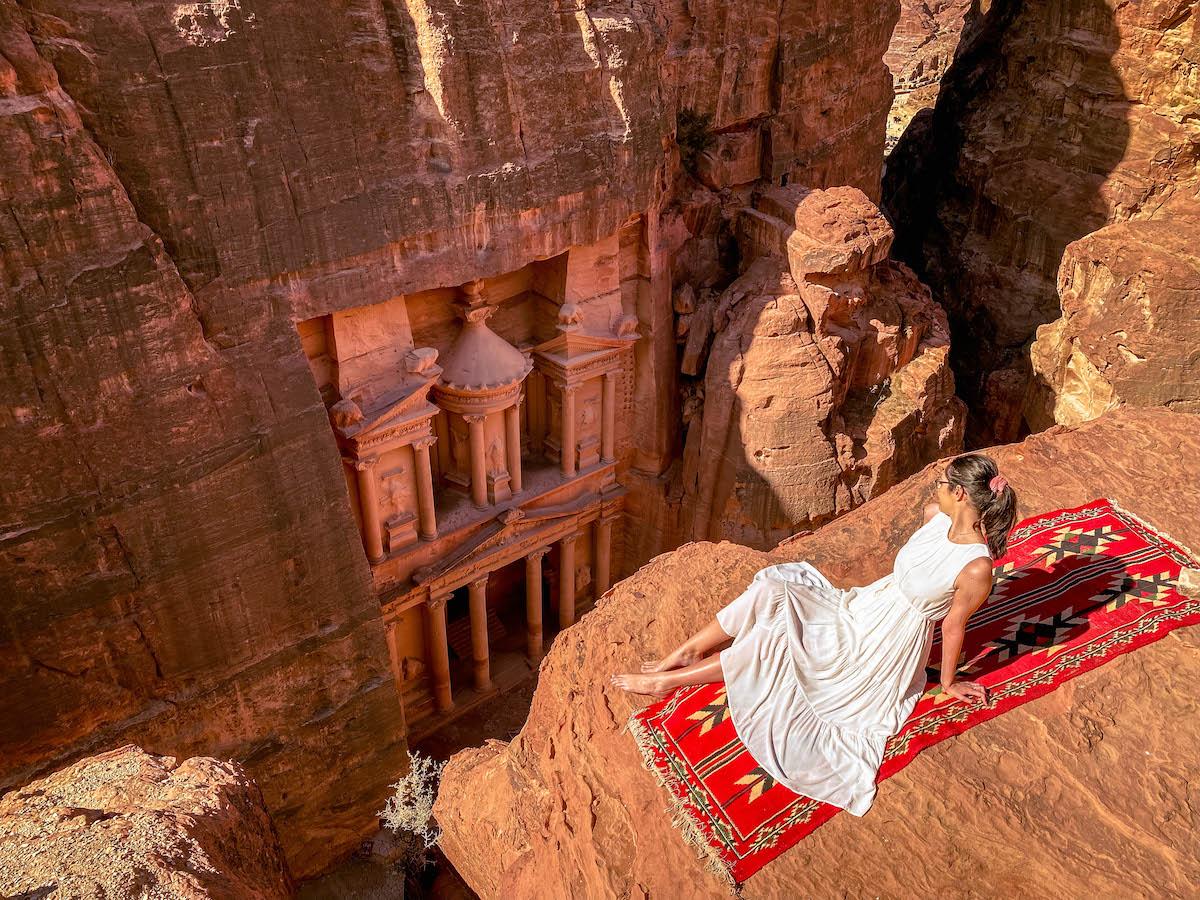
Petra Treasury, also known as Al-Khazneh, is an awe-inspiring ancient archaeological site located in Jordan. This magnificent structure, carved entirely out of rose-red sandstone, captivates visitors from all around the world with its grandeur and mystery. Steeped in history and culture, Petra Treasury stands as a testament to the architectural brilliance of the Nabateans, an ancient Arab civilization.
With its intricate carvings and ornate details, Petra Treasury is not just a landmark; it is a window into the past. This UNESCO World Heritage Site showcases the cultural fusion of different civilizations that once thrived in this region. From its enigmatic facade to its hidden chambers, Petra Treasury continues to fascinate and intrigue archaeologists, historians, and travelers alike.
In this article, we will delve into some unbelievable facts about Petra Treasury that will ignite your curiosity and deepen your appreciation for this remarkable landmark.
Key Takeaways:
- Petra Treasury, also known as Al-Khazneh, is a stunning archaeological masterpiece in Jordan, carved into towering sandstone cliffs. It’s a UNESCO World Heritage Site and a symbol of ancient engineering and cultural influence.
- The Petra Treasury’s intricate carvings, mysterious history, and Hollywood fame make it a must-see wonder of the world. It’s a gateway to the ancient city of Petra, showcasing the rich history and architectural marvels of Jordan.
A Breathtaking Beauty
The Petra Treasury is renowned for its stunning facade, intricately carved with classical Greek and Egyptian influences. The intricate details and ornate columns showcase the remarkable craftsmanship of the Nabateans.
A Forgotten City
Petra, once a thriving city and capital of the Nabatean Kingdom, remained hidden from the Western world for centuries until its rediscovery in 1812 by Swiss explorer Johann Ludwig Burckhardt.
A Trading Powerhouse
Established as early as the 4th century BC, Petra played a vital role in the lucrative trade routes that connected the Arabian Peninsula, Egypt, and the Mediterranean.
A Natural Defensive Position
Surrounded by towering cliffs and accessible only through a narrow gorge called the Siq, Petra Treasury was strategically built to provide protection against enemies.
An Engineering Marvel
The Treasury was carved out of a single solid rock cliff, measuring around 30 meters high. It is a testament to the architectural ingenuity of the Nabateans.
A Hollywood Star
The magnificent facade of the Petra Treasury gained international fame when it was featured in the film “Indiana Jones and the Last Crusade.
A Symbol of Wealth
The Treasury’s name, Al-Khazneh, translates to “The Treasury” in Arabic. It is believed that this name originated from a myth that hidden treasure was once stored within its walls.
A Mysterious Purpose
The true function of the Petra Treasury remains unknown. While it is often referred to as a tomb, no conclusive evidence has been found to support this theory.
A Witness to History
Over the centuries, Petra Treasury has seen the rise and fall of empires, including the Nabateans, Romans, Byzantines, and eventually fell into decline due to changing trade routes.
A UNESCO World Heritage Site
Petra, with its Treasury as the centerpiece, was designated as a UNESCO World Heritage Site in 1985, recognizing its outstanding universal value and historical significance.
A True Wonder of the World
Petra Treasury was included as one of the New Seven Wonders of the World in 2007 after a global vote, solidifying its place as a must-see destination for travelers.
A Testament to Nabatean Culture
The intricate carvings and architectural style of the Petra Treasury reflect the blend of Nabatean, Hellenistic, and Roman cultures, showcasing the rich history and influence of the region.
A Hidden Water Supply
Beneath the Treasury lies a sophisticated water system, with channels and cisterns to collect and store water—an essential resource in the arid desert environment of Petra.
A Spectacular Night Time Display
Visitors to Petra have the opportunity to witness the Treasury illuminated by hundreds of candles during the magical Petra By Night event.
A Gateway to Petra’s Ancient City
The Petra Treasury is just the beginning of the wonders that await within the ancient city of Petra. Exploring further reveals captivating tombs, temples, and other historical sites.
A Modern Symbol of Jordan
Petra Treasury and the wider Petra archaeological site have become iconic symbols of Jordan, attracting tourists from all over the world to experience its awe-inspiring beauty.
These 16 unbelievable facts about Petra Treasury only scratch the surface of the wonders and mysteries that await within this ancient city. Plan a visit and immerse yourself in the rich history and architectural marvels that make Petra a true gem of the world.
Conclusion
The Petra Treasury is undoubtedly one of the most awe-inspiring landmarks in the world. Its breathtaking architecture, rich history, and intriguing mysteries have captivated visitors for centuries. From its intricate rock-cut façade to its hidden chambers and secret passages, this ancient wonder continues to amaze and inspire all who lay eyes on it.
Visiting the Petra Treasury is a truly unforgettable experience. Whether you are an avid history enthusiast or simply appreciate architectural marvels, this iconic landmark is a must-see destination. The sheer scale and beauty of the Treasury will leave you in awe, and the stories and legends embedded within its ancient walls will transport you back in time.
So, if you’re ever planning a trip to Jordan, make sure to include a visit to the Petra Treasury on your itinerary. Prepare to be amazed and let the wonders of this ancient city unfold before your eyes.
FAQs
1. What is the Petra Treasury?
The Petra Treasury is an ancient rock-cut temple located in the archaeological city of Petra, Jordan. It is renowned for its intricate façade and historical significance.
2. How old is the Petra Treasury?
The exact age of the Petra Treasury is uncertain, but it is believed to have been constructed in the 1st century BCE by the Nabateans, an ancient Arab civilization.
3. Why is it called the Treasury?
The name “Treasury” comes from a local Bedouin legend that suggested the urn on top of the structure contained hidden treasures. However, it is actually a royal tomb.
4. Can visitors enter the Petra Treasury?
No, visitors cannot enter the actual Treasury. However, you can admire its remarkable façade and explore the surrounding areas, including the Siq, a narrow gorge that leads to the Treasury.
5. Are there other notable landmarks in Petra?
Absolutely! Petra is home to many remarkable landmarks, including the Monastery, the Royal Tombs, the Amphitheatre, and the High Place of Sacrifice, among others. Each of these landmarks offers a unique glimpse into Petra’s fascinating history.
6. How can I visit the Petra Treasury?
You can visit the Petra Treasury by purchasing a ticket at the visitor center. The Treasury is accessible by walking through the winding Siq, which is a memorable experience in itself.
7. Is Petra a UNESCO World Heritage site?
Yes, Petra was designated as a UNESCO World Heritage site in 1985. It is recognized for its outstanding universal value and unique cultural significance.
8. Can you climb the Petra Treasury?
For safety reasons, climbing the Petra Treasury is not allowed. To preserve its integrity and prevent any damage, visitors are encouraged to admire it from ground level.
Petra's Treasury is a true marvel, but it's just one of many incredible ancient sites waiting to be explored. From the mysterious ruins of Tiwanaku, an ancient civilization that left behind stunning monuments, to Samarra Archaeological City, where archaeologists have uncovered a wealth of history, there's no shortage of fascinating places to discover. And let's not forget about Mada'in Salih, a Nabatean city that rivals Petra in its beauty and grandeur. So why not embark on a journey through time and uncover the secrets of these remarkable ancient wonders?
Was this page helpful?
Our commitment to delivering trustworthy and engaging content is at the heart of what we do. Each fact on our site is contributed by real users like you, bringing a wealth of diverse insights and information. To ensure the highest standards of accuracy and reliability, our dedicated editors meticulously review each submission. This process guarantees that the facts we share are not only fascinating but also credible. Trust in our commitment to quality and authenticity as you explore and learn with us.


